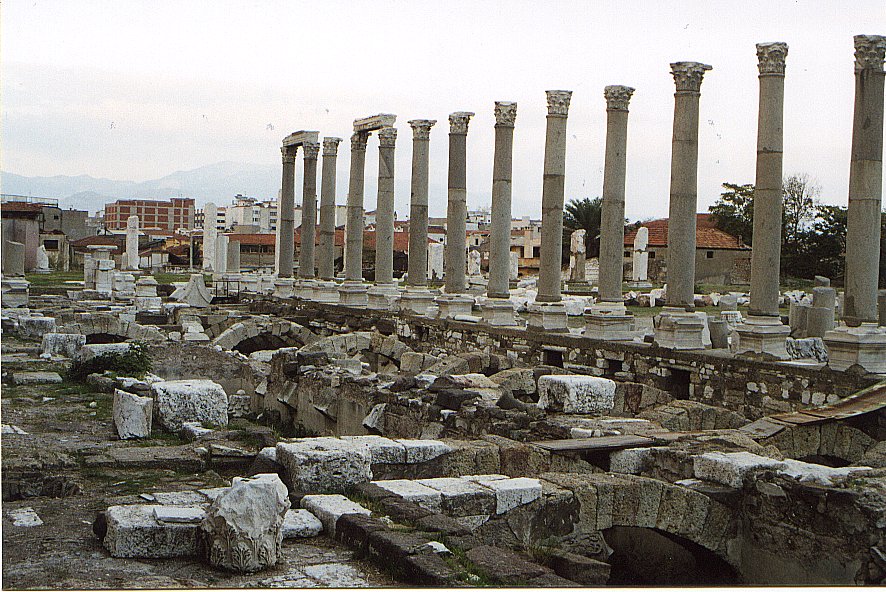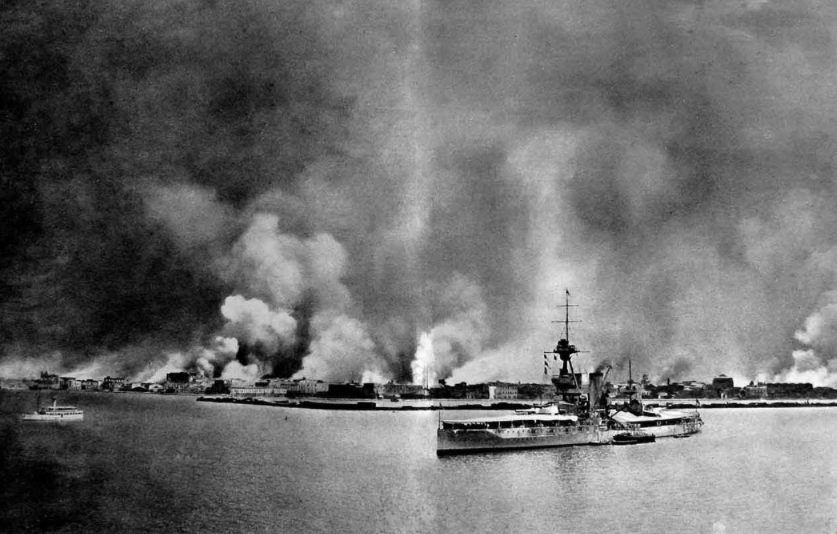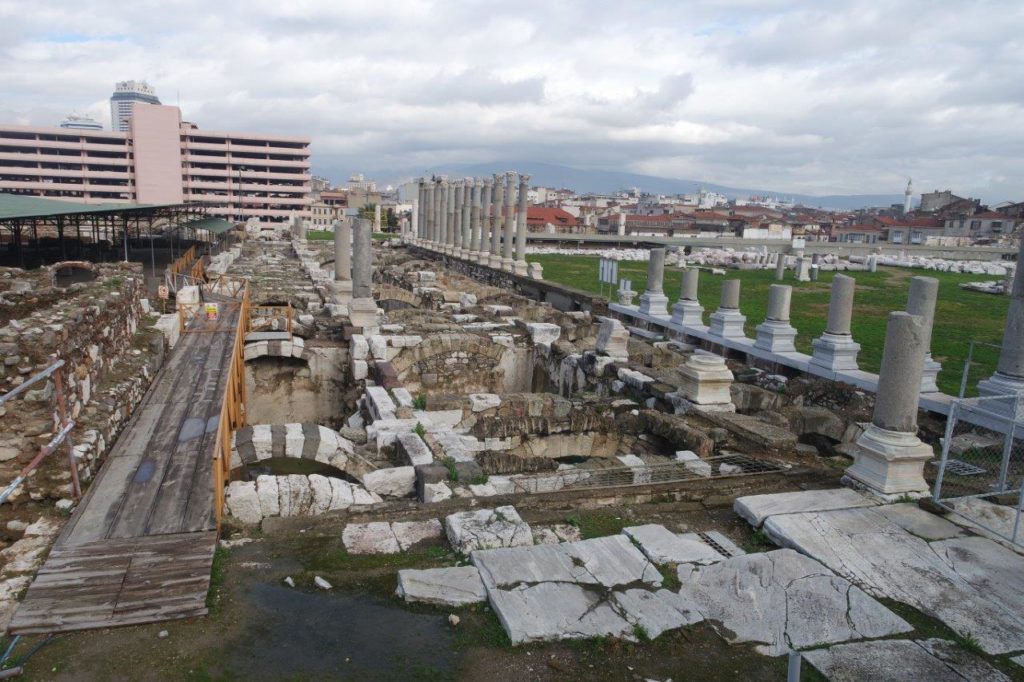On June 21, Turkish media reported that the Saint-Jean Theologos Greek Girls School in Smyrna, now known as Izmir, which has been empty since the extermination of the city's Greek Christians in 1922, was plundered, its doors and windows removed and its valuables looted. The historic building, now owned by Turkish Undersecretariat of the Treasury, has mostly been used by homeless drug addicts.

Today, the school no longer has Greek students or teachers. For 97 years ago, the 3,000-year Greek presence was erased from the city through what is known as the 1922 Great Fire of Smyrna.

The Greek culture, however, was not a foreign way of life in Asia Minor. The region was predominantly Greek before Turkic people began to invade it in the 11th century.
Asia Minor and Smyrna have enormous importance for Hellenism and Christianity. The Metropolis of Smyrna, an ecclesiastical territory (diocese) of the Ecumenical Patriarchate of Constantinople, retained its ecclesiastical autonomy until 1922. Smyrna was also one of the Seven Churches spoken of by St. John in the biblical book of Revelation. Janene Keeth, a scholar of Christian education, wrote that “Smyrna has been described as the most beautiful of the seven cities. Presumably, this church was founded during Paul’s ministry in Ephesus (Acts 19:10).”
According to the International Dictionary of Historic Places: Southern Europe, ancient Greeks were the ones “who raised Smyrna to heights of power and glory in the seventh century B.C. Smyrna passed into the hands of the Christianized, Greek-speaking Byzantine realm following the formal division of the Roman Empire.”

Smyrna was ruled by Christians for centuries. The Eastern Roman (or Byzantine) Empire fought fierce defence wars against Arabic, Seljuk, and Ottoman Islamic armies. Riding from the steppes of Central Asia, the Turks targeted Asia Minor by combining their long-held “tradition of invasion” with newfound Islamic zeal. The Islamic invasion of Asia Minor was completed by the Ottomans through the fall and looting of Constantinople (Istanbul) in the 15thcentury.
The events surrounding the Greek landing at Smyrna in 1919 and the great fire in the city in 1922 could be better understood if analysed as part of the systematic campaign against Christians by Ottoman Turkey.
During World War I, the decaying Ottoman Empire adopted a policy that many scholars have called “the forced Turkification of Asia Minor.” George Makredes described the period as follows:
“Imagine a life where it’s a crime to celebrate or reveal your ethnic heritage; where the law requires you to abandon your ways and culture and meld invisibly into one indistinguishable mass with the majority or suffer the consequences. And woe to anyone caught reading, speaking, dressing as, or playing music of another culture.”
“Welcome to Asia Minor during the early part of the 20th century. It was during this grim period when over 1.5 million Armenians were systematically exterminated. Whether you were an Armenian man, woman or infant, you were fair game to be cut down on sight, per order of the state. Unarmed and powerless, Greeks witnessed this horror, terrorized with the fear that they were next.”

What they feared soon became a reality.
Like Armenians, Greeks also fell victim to the same Ottoman campaign of systematic extermination of Christians before, during and after World War I (1914–1923). According to the Greek Genocide Resource Center, atrocities against Greek people during that period “included massacres, forced deportations and death marches, summary expulsions, boycotts, rape, forced conversion to Islam, conscription into labor battalions, arbitrary executions, and destruction of Christian Orthodox cultural, historical and religious monuments.”
At the end of World War I and with the Armistice of Mudros that ended the Ottoman front in the war, the allies launched a series of peace talks that focused on the future of the Ottoman Empire. According to James Marketos, an American Hellenic Institute board member, “By 1919, the allied winners of World War I – England, France, Italy, and the U.S. – were still arguing over how to divide up the defunct Ottoman Empire, which had sided with Germany. In May that year, the Greek army was permitted to land at Smyrna and establish an administrative zone.”
Scholars Evangelia Boubougiatzi, Ifigenia Vamvakidou, and Argyris Kyridis wrote in Greeks’ Identities in Smyrna, 19th – 20th Century Local and Global Parameters that “In that society, Greeks had the dominant position, both in a demographic and economic level.” Smyrna was also one of the centers of Greek enlightenment culture, with several schools erected, such as the Evangelical School and the Philological Gymnasium.

“From ancient times, and through the Roman, Byzantine and Ottoman ages, the city remained essentially Greek,” according to Marketos. “The later centuries saw the advent of Armenian, Turkish, Jewish, European and American influences, but through it all, the predominant spirit remained Greek.”
But this ended when Turkish military forces attempted to take back Smyrna from the Greek administration on September 9, 1922. The military attacks against the Greeks and Armenians of Smyrna began with looting, rapes, and murder. Marketos wrote:
“They started in the Armenian quarter and then spread through the Greek portion of the city. This drove even more people to the narrow sea-front. Then, on September 13, a fire started in the Armenian part of the city. A strong breeze blew the fire away from the Turkish quarter and quickly spread it to the rest of the city, driving still more horrified thousands of Greeks and Armenians to the harbor where they were now trapped between the raging flames at their backs and the harbor in front. And still, the Allied warships watched as the refugees on the sea-front were subjected to unspeakable atrocities by Turkish soldiers and residents.
“After four days, the fire burned itself out. Beautiful Smyrna lay in ruins. Thousands of Greeks and Armenians had perished, either in the fire, or through slaughter in one form or another, or through simple exposure. Hundreds of thousands of others were eventually evacuated. But either way, the Twentieth Century’s first holocaust effectively ended the Christian presence in Asia Minor.”
Sadly, this dark page of history remains mostly forgotten or ignored. Only a handful of scholars have shed light on and exposed the persecution of Christians in Smyrna in 1922. One is Lou Ureneck, Boston University professor and journalist, who penned The Great Fire: One American’s Mission to Rescue Victims of the 20th Century’s First Genocide. In it, he described the harrowing story of an American Methodist minister – Asa Kent Jennings – and an American naval officer – Arthur J. Hepburn – who helped rescue more than 250,000 Christian refugees during the burning of Smyrna by Turkish forces.
“A half a million people, packed into a narrow strip of pavement, maybe a mile and a half, two miles long, as a giant fire comes at them, basically pushing them into the sea,” Ureneck said in an interview with the Bostonia magazine. “And many of them did jump into the sea, either trying to swim to ships, or committing suicide, or their clothes and packages had caught on fire.”
During that period, Turkish soldiers burned and plundered Smyrna’s Christian neighbourhoods, murdering defenceless residents. Scholar Speros Vryonis reported that among them was Chrysostomos Kalafatis, the metropolitan of Smyrna.
“The great fire of Smyrna was the peak of the Asia Minor catastrophe, bringing an end to the 3,000-year Greek presence on Anatolia’s Aegean shore and shifting the population ratio between Muslims and non-Muslims,” journalist Ioanna Zikakou wrote.
However, even 97 years later, the Turkish government continues trying to cover up its role in the fire and the slaughter of Greeks and Armenians. According to Turkish official narrative, the city was burned by Greek soldiers and what Turks did was just to react in self-defense. For decades, the Turkish official state ideology has glorified September 1922. “We have thrown the Greeks into the sea” is a common and proudly used expression in Turkey.
Genocide in Numbers
Anatolia was almost completely cleansed of its Christian population by the time the Turkish republic was founded in 1923. As Dr. Benny Morris and Dror Ze’evi, the authors of The Thirty-Year Genocide: Turkey’s Destruction of Its Christian Minorities, 1894-1924, point out:
“Between 1894 and 1924, the number of Christians in Asia Minor fell from some 3-4 million to just tens of thousands—from 20% of the area’s population to under 2%.”
In 2007, the International Association of Genocide Scholars, the pre-eminent academic authority on genocides, passed a resolution stating:
“Be it resolved that it is the conviction of the International Association of Genocide Scholars that the Ottoman campaign against Christian minorities of the [Ottoman] Empire between 1914 and 1923 constituted a genocide against Armenians, Assyrians, and Pontian and Anatolian Greeks.”
The Saint-JeanTheologos Greek Girls School in Smyrna is not the only Greek school or cultural structure that has been left to decay in Turkey.
The homes, shops, schools, factories, and churches, among other properties, belonging to the Greeks disappeared or were converted to other uses following the genocide. They were either destroyed outright or left to deteriorate by neglect. And many have been used as mosques, private houses, stables, warehouses and for other purposes by the Turks and Kurds.
On April 7, 2017, for instance, the Turkish newspaper Hurriyet published a news story titled: “Ruined Aegean houses going for premium prices.” However, a more truthful title for the report would be “Ruined Greek houses in Smyrna emptied of its original inhabitants through genocide going for premium prices.”
Combine the intense propaganda in Turkey denying the genocide with the continued seizure of Greek properties and the destruction of Greek cultural heritage and it appears that Turkey has been using its resources to wipe out all the remaining traces of Greek civilization in Asia Minor.
Note: Parts of this article are excerpts from an article Bulut wrote for the Philos Project website in 2017.
 ABOUT Uzay Bulut: Uzay Bulut is a Turkish journalist and political analyst formerly based in Ankara. Her writings have appeared in various outlets such as the Gatestone Institute, Washington Times, Christian Post and Jerusalem Post. Bulut's journalistic work focuses mainly on human rights, Turkish politics, and history, religious minorities in the Middle East and anti-Semitism. Bulut has now also become a contributor for Greek City Times.
ABOUT Uzay Bulut: Uzay Bulut is a Turkish journalist and political analyst formerly based in Ankara. Her writings have appeared in various outlets such as the Gatestone Institute, Washington Times, Christian Post and Jerusalem Post. Bulut's journalistic work focuses mainly on human rights, Turkish politics, and history, religious minorities in the Middle East and anti-Semitism. Bulut has now also become a contributor for Greek City Times.

